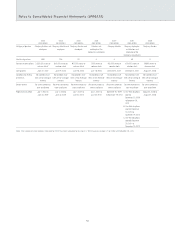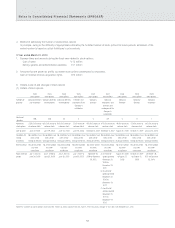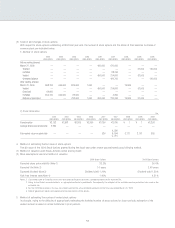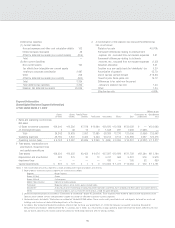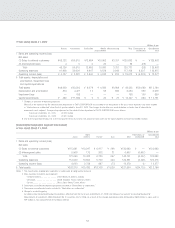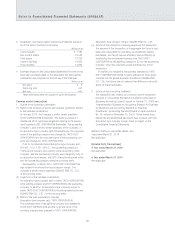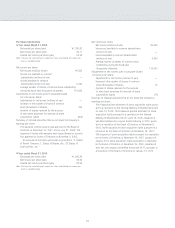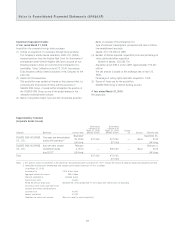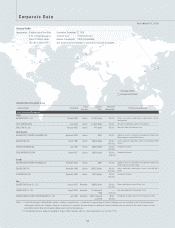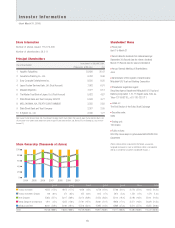Square Enix 2010 Annual Report Download - page 62
Download and view the complete annual report
Please find page 62 of the 2010 Square Enix annual report below. You can navigate through the pages in the report by either clicking on the pages listed below, or by using the keyword search tool below to find specific information within the annual report.
Notes to Consolidated Financial Statements (JPNGAAP)
5. Breakdown of principal assets received and liabilities assumed
as of the date of business combination
Millions of yen
Current assets ¥ 7,786
Non-current assets 19,543
Total assets 27,329
Current liabilities 14,654
Total liabilities 14,850
6. Estimated impact on the Consolidated Statements of Income in this
fiscal year calculated based on the assumption that the business
combination was completed on the first day of the fiscal year
Millions of yen
Net sales ¥ 0
Recurring loss 447
Net loss 447
These estimates were not subject to audit certification.
Common control transactions
1. Outline of the business combination
(1) Name of the company acquired and business operations subject
to the business combination
In February 2010, the Company’s wholly owned subsidiary
TAITO CORPORATION (hereinafter “the splitting company”)
transferred all its rights and obligations relating to the amuse-
ment business to ES1 CORPORATION (hereinafter “the succeeding
company”), also a wholly owned subsidiary of the Company, in
an absorption-type company split. Simultaneously, the corporate
name of the splitting company was changed to TAITO SOFT
CORPORATION and the corporate name of the succeeding com-
pany was changed to TAITO CORPORATION.
Prior to the aforementioned absorption-type company split,
SPC-NO. 1 CO., LTD. (“SPC1”), the succeeding company’s
100% parent company and a wholly owned subsidiary of the
Company, and the succeeding company were merged by way of
an absorption-type merger, with SPC1 being the absorbed entity
and the succeeding company being the surviving entity.
Subsequently, in March 2010, TAITO SOFT CORPORATION
was subject to an absorption-type company merger. The
Company’s wholly owned subsidiary SQUARE ENIX CO., LTD.,
is the surviving entity.
(2) Legal form of the business combination
An absorption-type company split in which TAITO CORPORATION
is the splitting company and ES1 CORPORATION is the succeeding
company. In addition, an absorption-type company merger in
which TAITO SOFT CORPORATION is the extinguished entity and
SQUARE ENIX CO., LTD., is the surviving entity.
(3) Name of the post-combination company
Absorption-type company split: TAITO CORPORATION
The corporate name of the splitting company was changed to
TAITO SOFT CORPORATION and the corporate name of the
surviving company was changed to TAITO CORPORATION.
Absorption-type company merger: SQUARE ENIX CO., LTD.
(4) Outline of the transaction including purpose of the transaction
The purpose of the transaction is to aggregate the Group’s busi-
ness units responsible for operating its amusement-related
businesses, and hence improve efficiency and profitability by
transferring the amusement business from TAITO SOFT
CORPORATION as the splitting company to ES1 as the succeeding
company, which has operated arcade facilities prior to the
transaction.
In addition, by integrating the business operated by TAITO
SOFT CORPORATION related to game software for home game
consoles into the games business operated by SQUARE ENIX
CO., LTD., the Group aims to enhance the efficiency and profit-
ability of these businesses.
2. Outline of the accounting treatment
The transaction was treated as a common control transaction
pursuant to “Accounting Standard for Business Combinations”
(Business Accounting Council, issued on October 31, 2003) and
“Implementation Guidance on Accounting Standard for Business
Combinations and Accounting Standard for Business
Divestitures” (Accounting Standards Board of Japan Guidance
No. 10, revised on November 15, 2007). These transactions,
namely the aforementioned absorption-type company split and
absorption-type company merger, have no impact on the
Consolidated Financial Statements.
(Matters relating to real estate leases, etc.)
Year ended March 31, 2010
Not applicable
[Related Party Transactions]
■ Year ended March 31, 2009
Not applicable
■ Year ended March 31, 2010
Not applicable
60


